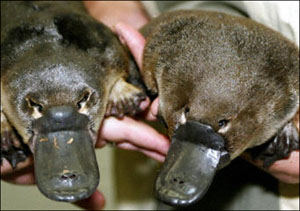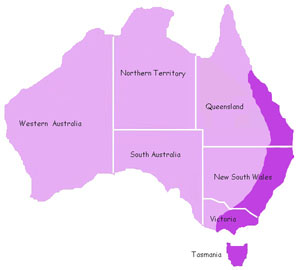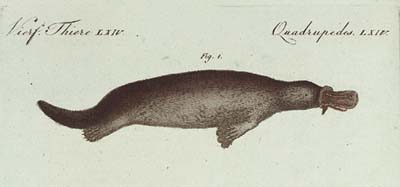Platypus Electroreception
Biology 342: Animal Behavior
Fall 2007
Author: Meera Patel
| Home | Phylogeny | Ontogeny | Mechanism | References |
Introduction
Platypuses are unusual creatures with unusual abilities.
Unlike any other mammal on this planet, platypuses have the curious ability to perceive underwater prey using underwater detection refered to as electroreception. Electroreception allows platypuses to use electrical impulses to locate objects in the deepest and darkest of waters.


Source: Discovery Channel and Nil (Wikipedia)
Scientific name: Ornithorhynchus anatinus
Habitat: eastern Australia and Tasmania
Upon their discovery, platypuses were met with suspicion. Over two centuries ago, the governor of colony in Sydney sent the fur of an animal to European biologists that he could only describe as a “small amphibious animal of the mole kind which boroughs in the banks of the fresh water lakes.” Included with his package was the closest earliest illustration of platypuses to date shown below (Griffiths 1998).

Source: printed in Griffiths 1998
Many scientists believed that these animals were a hoax, merely a mammal costumed with a duck-bill and webbed feet (Griffiths 1998). Even in our modern day, the idea of a mammal that lays eggs rather than delivering life offspring seems counterintuitive. When platypuses were finally accepted as legitimate animals, the science world was further perplexed by the unusual animals’ ability to hunt prey in deep stygian waters without the use of sight, sound, or smell. In 1802, Sir Everard Home was the first to elucidate the details of monotreme physiology and discovered that “of the trigeminal nerves," the nerves that supply sensory stimuli to the brain from face, teeth and tongue, ‘the fifth pair which supplies the muscles of the face, are uncommonly large… Therefore, the sensibility of the different parts of the bill are very great, answers the purpose of a hand, and is capable of nice discrimination in its feeling’”(qtd. in Griffiths 1998). This observation went unnoticed until the latter part of the 20th century, when it was rediscovered that platypuses are gifted with an unusual bill, a finely orchestrated mechano- and electro-sensory organ that pinpoints the exact location of deep sea prey.
Electroreception conferred by this “bill sense” explains the platypus’s accurate navigation through light-limited areas. This idea was first suggested when pores on the bill skin demonstrated morphological similarities to the ampullary electroreceptors in electric fish (Pettigrew 1999). Ampullary electroreceptors allow response to low-frequency electric signals that are generated by animal nerves and hearts and it was theorized that the bill functions the same way (Sherwood 2004).
Platypus electroreception was first demonstrated in Australia and detection strengths were measured at 300 μV per cm. Electroreceptive afferents, or sensory input, from the trigeminal nerve described earlier by Home were also later measured to be comparable to that of electric fish (Pettigrew 1999). This website will explore recent discoveries of Platypus electroreception from that point on.